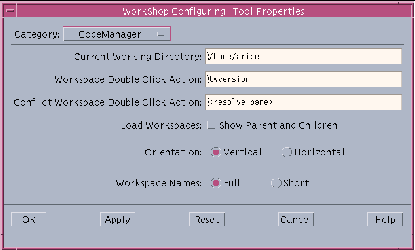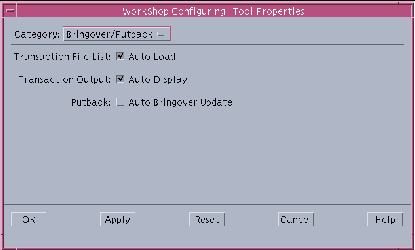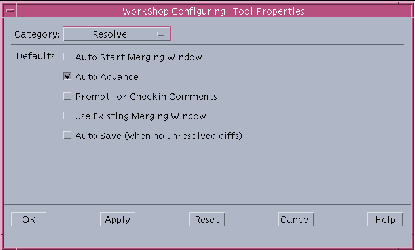Starting TeamWare Configuring
To start TeamWare Configuring, at a shell command prompt type twconfig followed by the ampersand symbol (&).
| demo% twconfig& |
After a moment, the Configuring window appears.
TeamWare Configuring Windows
Configuring consists of a main window (see Figure 6-1) and a number of dialog boxes. Within the main window is a menu bar from which you can choose items to help you accomplish your tasks. The online help contains a full explanation of TeamWare Configuring windows.
Configuring Window
When you start Configuring, the main window opens (see Figure 6-1). In working with Configuring, you select workspace icons in the Workspace Graph pane and then choose commands that act upon the selected workspaces and the files they contain.
Figure 6-1 Configuring Window With Parent and Child Workspaces Loaded

|
File menu |
Provides commands to load, unload, and create workspaces |
|
Edit menu |
Provides commands to delete, rename, reparent, and update workspaces |
|
View menu |
Provides commands to set view options in the Workspace Graph pane |
|
Transactions menu |
Provides commands for synchronizing files with Bringover, Putback and Resolve transactions |
|
Options menu |
Provides commands for setting Workspace and Configuring options |
|
TeamWare menu |
Provides command for starting other TeamWare tools |
|
Workspace Graph pane |
Displays a visual graph of the workspaces you have loaded |
Workspace Graph Pane
In the Workspace Graph pane each workspace is represented by a workspace icon. Parent and child relationships are depicted by lines connecting workspaces. The path name of the workspace top-level (root) directory is displayed beneath the icon.
Loading Workspaces into the Workspace Graph Pane
When Configuring is started, it checks the directory (or directories) specified by the environment variable CODEMGR_WSPATH to determine if it contains any workspaces. If workspaces are found, they are loaded into the Workspace Graph pane. If CODEMGR_WSPATH is not set, Configuring attempts to load workspaces from the directory in which it was started. To load additional workspaces, choose File > Load Workspaces.
Layout
Workspace hierarchy graphs are automatically created in the Workspace Graph pane by the Configuring program as you load workspaces (using the Load menu and the Load Workspaces dialog box (see "Customizing Configuring Using Tool Properties"). Hierarchies are displayed either vertically or horizontally starting from the upper-left corner and distributed to the right as space permits. You can select the orientation by choosing View > Orientation. Vertical orientation is the default. Layout is done automatically--you cannot change the layout by moving icons with the mouse.
Workspace Name Fields
Beneath the workspace icon is a text field that contains the name of the workspace root directory. You can choose to have workspace names displayed one of two ways:
-
Using the absolute (full) path name of the root directory
-
Using the truncated (short) name of root directory
Choose the display style you prefer by choosing Name >View.
You can change the path name of a workspace by editing the name text box.
Dragging and Dropping Workspace Icons
You can accomplish two types of operations by directly manipulating icons on the Workspace Graph pane. You can drag and drop workspace icons to initiate both Bringover and Putback transactions and to reparent workspaces.
-
Interworkspace transactions--If you select and drag a workspace and drop it on top of another icon, Configuring initiates one of the following transactions: Bringover Create, Bringover Update, Putback. You determine which transaction is initiated by which icon you drag, and where you drag it; Table 6-1 summarizes these actions. For more information about interworkspace transactions, see Chapter 8, Copying Files between Workspaces."
|
Drag: |
To: |
Action |
|---|---|---|
|
Any workspace icon |
Open area |
Activate Bringover Create transaction window |
|
Parent workspace icon |
Child workspace icon |
Activate Bringover Update transaction window |
|
Child workspace icon |
Parent workspace icon |
Activate Putback transaction window |
|
Any workspace icon |
A nonrelated (not a parent or child) workspace icon |
Activate pop-up notice to determine actions |
-
Reparenting--To use the drag and drop facility to change a workspace's parent, press and hold the SHIFT key while you drag the workspace icon on top of its new parent's icon. If you drag the icon to an open area of the Workspace Graph pane, the workspace will be orphaned (have no parent). The display is automatically adjusted to reflect the new relationship. For more information about reparenting workspaces, see "Reparenting a Workspace".
Note -You are prompted to confirm the reparent operation.
Double-Click Action
When you double-click when the pointer is over a workspace icon, the TeamWare Versioning is automatically started (with the selected workspace automatically loaded). See Versioning online help and Chapter 12, Performing Basic SCCS Functions with Versioning" for instructions on using Versioning.
If you double-click when the pointer is over the icon of a workspace that contains unresolved conflicts, Configuring automatically activates the Resolve transaction window. Conflicted files from the selected workspace are automatically loaded and ready for processing.
You can customize Configuring double-click behavior using the Tool Properties dialog box (see Table 6-2).
Customizing Configuring Using Tool Properties
Using the Tool Properties dialog box (see Table 6-2), you can customize the behavior of:
-
Configuring window functions
-
Bringover/Putback transactions
-
Resolve transaction
To open the Tool Properties dialog box, choose Options > Configuring. The Category list box in the dialog box lets you to switch between the Configuring, Bringover/Putback, and Resolve panes.
Configuring Defaults Files
When you change Configuring behavior using the Tool Properties window, you can use the Apply button to preserve the changes in runtime configuration files in your home directory. The runtime configuration files are consulted by Configuring when it starts; your changes are used as the default values.
Changes made in the Configuring and Bringover/Putback panes of the Tool Properties window are written to the file ~/.codemgrtoolrc. This file is an XWindows resource file.
Changes made in the Resolve pane of the Tool Properties window are written to the runtime configuration file ~/.codemgr_resrc.
Configuring Pane
The Configuring pane of the Tool Properties dialog box (see Table 6-2) enables you to change the behavior of the Configuring main window. The specific properties are described in Table 6-2.
Figure 6-2 Configuring Pane of the Tool Properties Dialog Box
 Table 6-2 Configuring Tool Properties
Table 6-2 Configuring Tool Properties|
Property |
Description |
|---|---|
|
Current Working Directory |
Lets you specify the directory to which Configuring actions are relative. |
|
Workspace Double Click Action |
Lets you specify the commands you want launched when you double-click on a standard workspace icon. Type the path name required to execute the commands based on the current working directory and your search path. By default, the standard workspace command is Versioning (twversion). |
|
Conflict Workspace Double Click Action |
Lets you specify the commands you want launched when you double-click icons of workspaces that contain conflicts. Type the path name required to execute the commands based on the current working directory and your search path. By default, the Resolve Transaction window (<resolve_pane>) is opened for conflicted workspaces. |
|
Load Workspaces |
Select this check box if you want the parent and children of workspaces you load in the Workspace Graph pane automatically loaded with them. By default this box is not checked. |
|
Orientation |
Select the Horizontal setting if you want the workspace hierarchy displayed horizontally from left to right in the Workspace Graph pane. Select the Vertical setting if you want workspace hierarchy displayed vertically from top to bottom. By default the Vertical setting is in effect. This property corresponds to the choosing View Orientation the Configuring main window. |
|
Workspace Names |
Select the Short setting if you want workspaces labelled with the shortest possible name in the Workspace Graph pane. Select Full if you want workspaces labelled with absolute path names. By default the Full setting is in effect. This property corresponds to choosing View Names in the Configuring main window. |
Bringover/Putback Pane
The Bringover/Putback pane of the Tool Properties dialog box (see Figure 6-3) enables you to change the behavior of the Bringover and Putback panes of the Transactions window. The specific properties are described in Table 6-3.
Figure 6-3 Bringover/Putback Pane of the Tool Properties Dialog Box
 Table 6-3 Bringover/Putback Tool Properties
Table 6-3 Bringover/Putback Tool Properties|
Property |
Description |
|---|---|
|
Transaction File List |
Selecting Auto Load causes Configuring to reread the Codemgr_wsdata/args file and load it into the File List pane whenever a new workspace is selected. You might choose to deselect this property when you want to use the same file list for a number of transactions involving different workspaces. |
|
Transaction Output |
If you select Auto Display, Configuring automatically displays the Transaction Output window during transaction execution. |
|
Putback |
If you select Auto Bringover Update, and a Putback transaction is blocked, Configuring automatically initiates a Bringover transaction to update the child workspace. |
Resolve Pane
The Resolve pane of the Tool Properties window enables you to change the behavior of the Resolve pane of the Transactions window. The specific properties are described in Table 6-4.
Figure 6-4 Resolve Pane of the Tool Properties Dialog Box
 Table 6-4 Resolve Tool Properties
Table 6-4 Resolve Tool Properties|
Property |
Description |
|---|---|
|
Auto Start Merging Window |
Causes Merging to start automatically when the Resolve transaction pane is chosen. |
|
Auto Advance |
Causes the next file in the list to be automatically loaded into Merging after the current file is resolved. |
|
Prompt for Checkin Comments |
A default comment is automatically supplied during checkin after you resolve a file. This property causes you to be prompted for an additional comment that is appended to the standard comment. |
|
Use Existing Merging Window |
If this property is set, an already running Merging process is reused during subsequent resolve operations. |
|
Auto Save (when no unresolved diffs) |
If this property is set, and all the changes in the file can be "automerged," the files will also be saved and checked in; you need not select the Merging Save button. |
- © 2010, Oracle Corporation and/or its affiliates
